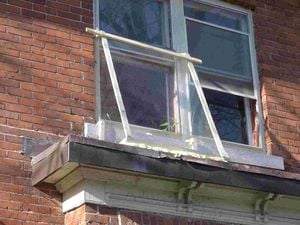|
|
| (7 intermediate revisions by 2 users not shown) |
| Line 3: |
Line 3: |
|
| |
|
| [[File:GreenhouseCLOSEUP.jpg|thumb|[[Construction of an Affordable Greenhouse]]]] | | [[File:GreenhouseCLOSEUP.jpg|thumb|[[Construction of an Affordable Greenhouse]]]] |
| '''Greenhouses''' capture [[solar energy]] and use it to create a warm environment for [[food production]]. | | '''Greenhouses''' are house-like constructions of about 2 m in height, most often composed of a metal frame on which glass rests. They are one (expensive) way of [[growing under cover]]. |
|
| |
|
| They can also be used (using an appropriate design) to [[Composting greenhouse provides hot water (original)|provide hot water]].
| | ==See also== |
| | | *[[Construction of an Affordable Greenhouse]] |
| Greenhouses, if properly protected with screens and without gaps for pests to enter, can offer advantages in [[pest control]]. However, they can also offer favorable conditions for pests to flourish, if pests are allowed to establish themselves. [[Biological pest control]] may be a suitable solution.
| | *[[Plastic bottle greenhouse]] |
| | | *[[Kiva's straw bale greenhouse]]: actually more akin to a conservatory, atleast if people were to use the construction as a house |
| [[Waste heat]] from industry can be used to heat greenhouses: [[Greenhouse waste heat exchange]]. | | *[[Humboldt greenhouse gallery]] |
| | | *[[The Food and Heat Producing Solar Greenhouse]] |
| They may be built from many materials, including:
| |
| * [[Straw bales]]: [[Kiva's straw bale greenhouse]] | |
| * [[Plastic bottles]]: [[Miniature greenhouses from plastic bottles]] and [[Plastic bottle greenhouse]]
| |
| * [[Cobb]]: [[Sequatchie Valley Institute cobb houses]]
| |
| ...although of course there must be a clear material (usually [[glass]] or [[clear plastic]] sheets) to allow in light and the sun's infrared rays.
| |
| | |
| ==Which plants are grown indoors/outdoors ?==
| |
| Annual herbs such as [[dill]], [[caraway]], [[basil]], [[borage]], [[chamomile]], garden [[marjoram]], [[chervil]], [[cumin]], [[parsley]], [[anise]], [[coriander]], and annual bean herb are sown. This is done in spring from late March, on site, in the soil. Also, frost-sensitive annual herbs such as basil are sown in March-April, under glass. Seeds that germinate slowly ([[parsley]]) too are better sown under glass.
| |
| | |
| The cutting of some plants (e.g. tarragon) is best done in a [[greenhouse]] because the cuttings are then in a growth-promoting climate and will dry-out less.
| |
| | |
| Herbs are not only supplied and used in their natural growing period. The cultivation of herbs can also continue during the winter months. In cold and temperate climates, the cultivation during the winter months is completely done in a greenhouse.
| |
| | |
| In a mild climate, (e.g. [[Sydney]] or [[Perth]] in [[Australia]], or the southern [[United States]]) many herbs can survive over winter. Some annuals, notably basil, may even be made to survive another year if cut back very hard (removing almost the entire bush) to prevent going to seed. This might need to be performed multiple times, especially removing any buds and flowers than manage to form.
| |
| | |
| According to the location of cultivation, we can make the following division:
| |
| | |
| A. Outdoor
| |
| * In full soil
| |
| * In container
| |
| | |
| B. Sheltered
| |
| * In full soil
| |
| * In container
| |
| * In pot or press pot
| |
| * In trays or multi plates
| |
| | |
| == See also ==
| |
| * [[Construction of an Affordable Greenhouse]]
| |
| * [[Humboldt greenhouse gallery]] | |
| * [[The Food and Heat Producing Solar Greenhouse]] | |
| | |
| == Interwiki links ==
| |
|
| |
|
| | == External links == |
| * [[Wikipedia:Greenhouses]] | | * [[Wikipedia:Greenhouses]] |
| | * [https://www.earthava.com/top10-10-best-greenhouse-kits/ Backyard Greenhouse Kits] |
|
| |
|
| {{Solar navbox}} | | {{Solar navbox}} |
|
| |
|
| |
|
| [[Category:Agriculture]] | | [[Category:Agriculture]] |
| [[Category:Solar]] | | [[Category:Solar]] |
| [[Category:Construction]] | | [[Category:Construction]] |

